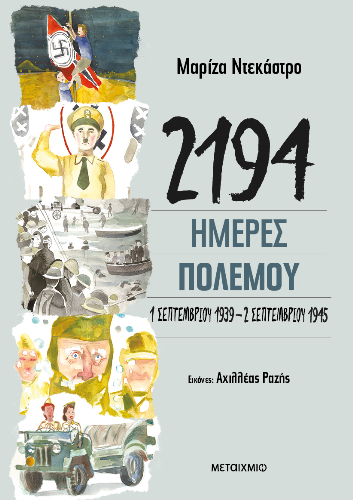
© www.greeknewsagenda.gr
Грецька письменниця Маріса де Кастро привернула особливу увагу літературної спільноти завдяки своїй новій книжці «2194 дні війни». Це глибоко продумане й візуально насичене видання охоплює весь період Другої світової війни — від 1 вересня 1939 року до 2 вересня 1945 року. Назва книги — не метафора, а точна кількість днів, протягом яких тривав глобальний конфлікт. У центрі книжки — людські обличчя історії: діти, які рятувалися від нацистів, солдати, що писали листи з фронту, митці, які не припиняли творити. Завдяки співпраці з істориками Гаґеном Фляйшером та Анною-Марією Друмпуккі авторці вдалося досягти максимальної достовірності. Де Кастро не прагне спростити або прикрасити події — вона говорить із молодим читачем чесно, але зрозуміло. Її творчість вирізняється глибоким історичним і соціальним контекстом, що допомагає читачам, особливо молодим, краще зрозуміти складні сторінки минулого. Важливу роль у проєкті відіграв ілюстратор Ахіллес Разіс, який розфарбував історичні чорно-білі фотографії, надавши їм нового життя та емоційного звучання для сучасного читача. Маріса де Кастро не обмежується сухим викладом фактів — вона вплітає у текст особисті історії й свідчення, які надають історії людське обличчя. Вона переконана, що щирість і чесність у викладі навіть найтяжчих тем — таких як Голокост чи війна — сприяють формуванню справжнього історичного усвідомлення у молодого покоління. Письменниця має значний досвід викладання історії для дітей і підлітків, а також роботи як літературна критикиня у сфері дитячої та юнацької літератури. Вона активно підтримує ідею, що література повинна бути доступною та захопливою для молоді, допомагаючи їм пізнавати минуле через живі сюжети та багатогранні образи.
Marisa De Castro: Literature That Brings History Close
." This deeply thoughtful and visually rich publication covers the entire duration of World War II — from September 1, 1939, to September 2, 1945. The book's title is not a metaphor but the exact number of days the global conflict lasted. At the heart of the book are the human faces of history: children escaping the Nazis, soldiers writing letters from the front, artists who never stopped creating. Thanks to her collaboration with historians Hagen Fleischer and Anna-Maria Droumpouki, De Castro achieved a remarkable level of historical accuracy. She doesn’t try to simplify or embellish the events — she speaks to young readers with honesty, yet in a way that is clear and accessible. Her work stands out for its deep historical and social context, helping readers — especially young ones — better understand the complex pages of the past. Illustrator Achilleas Razis also played a crucial role in the project by colorizing archival black-and-white photographs, breathing new life and emotional resonance into them for today’s audience. Marisa De Castro doesn’t limit herself to a dry recounting of facts — she weaves personal stories and testimonies into the narrative, giving history a human face. She firmly believes that sincerity and honesty, even when dealing with the most difficult topics such as the Holocaust or war, are essential to developing genuine historical awareness in younger generations. With extensive experience teaching history to children and teenagers, as well as working as a literary critic in the field of children’s and young adult literature, De Castro passionately supports the idea that literature should be both accessible and engaging for young people — helping them explore the past through vivid narratives and multi-layered imagery.

©
1380